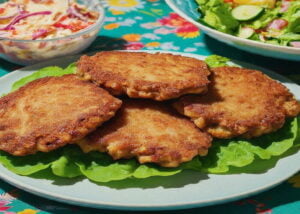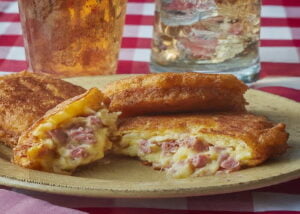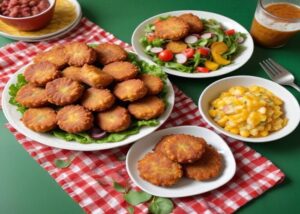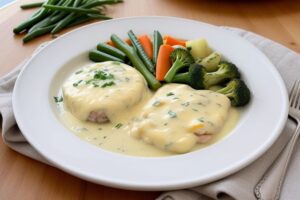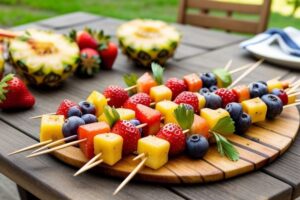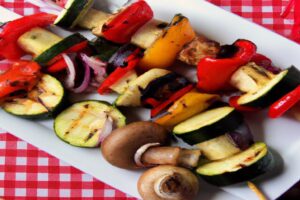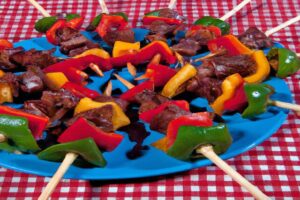Appetizers are a popular way to start a meal or to enjoy as a snack with friends and family.
From finger foods to small plates, this ultimate guide to appetizers covers everything you need to know about types, serving sizes, and more.
Get ready to impress your guests!
The Ultimate Guide to Understanding Appetizers

Appetiser or Appetizer
Good question, appetizers or appetisers?
It’s pretty simple.
“Appetiser” is the preferred way of spelling in the UK, Australia and New Zealand, while “Appetizer” is the American and Canadian spelling.
What that means is that both spellings are correct as the American spelling has gained large acceptance internationaly.
What are appetizers and why are they important?
Appetizers are small dishes or snacks served before a meal or as a standalone dish.
They are important because they can set the tone for the meal, stimulate the appetite, and provide a variety of flavours and textures.
They may be served at the dinner table as a part of the meal, or they may be served before seating.
Appetisers may also be served at late parties that occur after a regular meal time.
Or a mid-afternoon party where there is no intent to serve dinner, or an evening party that occurs after dinner, may also offer these foods so that guests can have the opportunity to snack.
They’re an especially good idea when guests are consuming alcohol, since they help to cut down on alcohol absorption.
Appetizers can also be a great way to showcase a chef’s creativity and culinary skills.
Additionally, they can be a fun and social way to enjoy food with friends and family.
How to create a balanced appetizer menu for a party or event.
When planning a party or event, it’s important to create a balanced appetizer menu that offers a variety of flavours, textures, and types of dishes.
Start by selecting a few different categories of appetizers, such as dips and spreads, hot and savoury bites, and cold and refreshing options.
Within each category, offer a mix of vegetarian and meat-based options, as well as options that cater to different dietary restrictions or preferences.
Don’t forget to consider the presentation of your appetizers, as well – arranging them on platters or in decorative bowls can make them even more appealing to your guests.
And finally, be sure to offer a variety of drink options to pair with your appetizers, as this can enhance the overall experience for your guests.
Serving Sizes:
How Much to Make for Your Party.
When it comes to serving sizes for appetizers, it’s important to consider the number of guests you’ll be hosting and the length of your event.
As a general rule, plan for each guest to have 2-3 bites of each appetizer.
If you’re serving a variety of appetizers, aim for 3-4 different types to ensure there’s something for everyone.
For a party of 10-12 guests, plan to make 30-40 pieces of each appetizer.
If you’re hosting a larger event, consider hiring a caterer or enlisting the help of friends to ensure you have enough food for everyone.
Pairing with Drinks:
The Perfect Combinations.
When it comes to appetizers, pairing them with the right drinks can take your party to the next level. For example, salty snacks like chips or pretzels pair well with a cold beer, while a cheese platter can be complemented by a glass of red wine.
For a more refreshing option, try serving a fruit or vegetable platter with a sparkling water or cocktail.
Cocktails can also be a great choice, with fruity or sweet cocktails pairing well with light, fresh appetizers, and stronger, more complex cocktails pairing well with heartier appetizers.
And for those who prefer non-alcoholic options, mocktails or flavored sparkling water can be a refreshing and tasty choice to pair with any type of appetizer.
Don’t be afraid to get creative and experiment with different flavour combinations to find the perfect pairing for your appetizers and drinks.
Types of Appetizers:
From Small Plates to Finger-Food.
Appetizers come in many different forms, each with their own unique characteristics and flavours.
Small bites, such as bruschetta or crostini, are perfect for a quick snack or as a pre-dinner appetizer.
Dips and spreads, like hummus or spinach and artichoke dip, are great for sharing and can be served with crackers, chips, or vegetables.
Charcuterie boards, featuring cured meats, cheeses, and fruits, are a popular choice for entertaining.
Other types of appetizers include soups, salads, and seafood dishes.
-
Cocktails
A cocktail could consist of a handful of bite-sized pieces that could be fish, shellfish, drinks and fruits
They must be fresh in appearance and arranged attractively to have an eye appeal.For example;
- Fish, crayfish, prawns, shrimps or oysters served with a tangy flavoured sauce.
- Chilled fruit juices such as orange, pineapple, grapefruit or tomato.
- Chopped fruit pieces coated in a natural yoghurt.
-
Hors d’ oeuvres
Hors d’ oeuvres are small portions of highly seasoned foods.
They are used to precede a meal served and are also intended to be eaten by hand. They can be either hot or cold.
Simplicity should be the main criteria for making the hors d oeuvres.
For example;- Small items served on a skewer, stick, or toothpick such as Bacon wrapped oysters, satay beef skewers, or cheese and fruit kebabs.
These can be artistically arranged, alternating items for colour as well as a blend of flavours, or the sticks can be dedicated to one item. - Small pastry shells filled with some savoury or sweet ingredient would also be a type of hors d’oeuvre.
A simple one savoury one would be mini-quiches.Small fried items such as meatballs, wontons, samosas, and egg rolls are often served with a dipping sauce.
- Cut raw vegetables served with a dip or even dips served with crackers or chips can be considered hors d’oeuvres as well.
A simple bowl of nuts would be hors d’oeuvres if served with drinks before dinner. - Deviled eggs are a classic, crowd-pleasing hors d’oeuvre that has many variations.
- Small items served on a skewer, stick, or toothpick such as Bacon wrapped oysters, satay beef skewers, or cheese and fruit kebabs.
-
Canape
A Canape is a bite-sized or two bite-sized finger food consisting of four parts: a base, a spread or topping and garnish or garniture. They are savoury titbits of food.
They could be served hot or cold. The items should be dainty, petite, fresh, having an eye appeal and colour contrasts.There are no set recipes for making canapes.
Individuals or a combination of several different coloured items are used on the small fancifully cut pieces of bread, toasted or fried, biscuits, etc.- A base of a small piece of bread, pastry or crackers.
Crostini and bruschetta are classic examples of canapés.Modern canapés may use a cracker, a small pancake (called blini) or even a pastry shell as the base.
- A flavourful spread such as real butter, flavoured cream cheese or mayonnaise.
The spread adds moisture and flavour while also forming a barrier so that the bread underneath doesn’t become soggy.
It also serves as a sort of glue, so that the toppings are less likely to slide off the base. - A topping of meat, seafood, vegetable, fruit or whatever.
This is the primary ingredient of the canapé, and the more luxurious the better.
Steak, prosciutto ham, smoked salmon, lobster and shrimp are excellent choices. - A garnish, usually something small, like tiny minced onions, herbs or caviar.
- A base of a small piece of bread, pastry or crackers.
-
Relishes/Crudite
Relishes/Crudite are pickled items and raw, crisp vegetables such as julienned carrots or celery sticks.
Relish varieties are generally placed before the guest in a slightly, deep, boat shape dish. -
Salads
Petite Salads are of small portions and they are usually displaying the characteristics found in the most salad.
Salads come in two types, Plain and Compound.
Plain salads would include;- Cucumber salad
- Tomato salad
- Beetroot salad
A Compound Salad could be;
- Salad Russe: Dices of mixed vegetables in mayonnaise.
- Salad Waldref: Dices of apple, celery, and walnut, bounded with mayonnaise.
- Caesar Salad: Caesar salad is Lettuce with vinaigrette dressing along with garlic, croutons, and grated parmesan cheese.
-
Soup
Soup is a teaser to the main course. They complement what is served after it.
Therefore, soups serve as an appetizer. Moreover, soups are seasoned with flavours that stimulate the appetite.The appetizing effect of soup is mainly due to the herbs or spices added to it.
Herbs and spices are well know to promote hunger and aid in proper digestion of the food.A good example of this is Chicken Taco Soup.
-
Dips
Savoury dips are popular accompaniments to dippers like tortilla chips, thicker potato chips, crackers, toasts and bagel crisps, bread sticks and pretzels, sliced apples and pears, and raw veggies work best with dips.
Proper consistency is important for many dips you prepare.It must not be so thick that it cannot be scooped up without breaking the dipper, but it must be thick enough to stick to the items used as dippers.
For creamy-smooth dips like a tasty hummus dip, you could go for crispy pita chips or bagel chips, potato chips and other vegie chips (like zucchini or kale).
Tips for making and serving appetizers at home.
Making and serving appetizers at home can be a fun and rewarding experience.
To start, choose appetizers that are easy to prepare and can be made ahead of time, such as dips, spreads, and skewers.
When it comes to presentation, use decorative platters, bowls, and serving utensils to make your appetizers look as appealing as possible.
Don’t be afraid to get creative with your presentation – for example, you could serve dips in hollowed-out vegetables or use edible flowers to garnish your dishes.
Finally, be sure to offer a variety of drink options to pair with your appetizers, such as wine, beer, or non-alcoholic beverages.
Appetizer Prep and Serving Tips
- Plan ahead:
Before your guests arrive, plan out your appetizer menu and make a list of ingredients.
This will help you stay organized and ensure that you have everything you need. You can also prepare some items in advance, such as dips or spreads, to save time on the day of the event. - Keep it simple:
When it comes to appetizers, less is often more. Stick to a few simple, crowd-pleasing options rather than trying to make too many different dishes. This will also make it easier for you to manage and serve the food. - Use seasonal ingredients:
Incorporating seasonal ingredients into your appetizers can add a fresh and flavourful touch.
Look for local produce at your farmers market or grocery store, and consider incorporating herbs or spices that are in season. - Consider dietary restrictions:
Be mindful of any dietary restrictions your guests may have, such as allergies or dietary preferences.
Offer a variety of options, including vegetarian, gluten-free, and dairy-free options, so that everyone can enjoy the food. - Presentation is key:
The way you present your appetizers can make a big difference in how they are received.
Use serving platters, bowls, and trays to create an attractive display, and consider adding garnishes or decorations to make the food look even more appealing. - Keep it bite-sized:
Appetizers should be easy to eat and not require utensils. Keep portions small and bite-sized, and provide napkins or small plates for guests to use. - Serve at the right temperature:
Make sure your appetizers are served at the appropriate temperature. Cold items should be kept chilled until ready to serve, and hot items should be kept warm in a slow cooker or warming tray. This will ensure that the food is safe to eat and tastes its best.
Easy Appetisers for Your Next Party
Hosting a party? Impress your guests with these easy and delicious appetiser and finger-food recipes. Perfect for any occasion!

